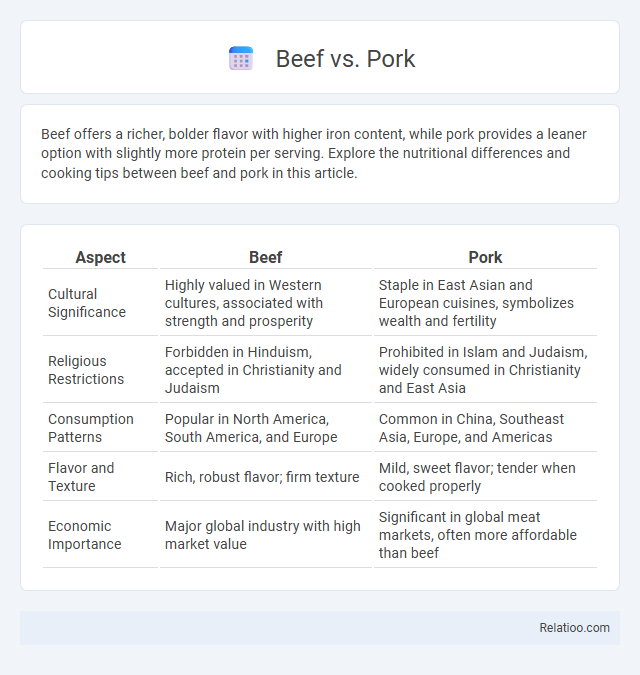Beef offers a richer, bolder flavor with higher iron content, while pork provides a leaner option with slightly more protein per serving. Explore the nutritional differences and cooking tips between beef and pork in this article.
Table of Comparison
| Aspect | Beef | Pork |
|---|---|---|
| Cultural Significance | Highly valued in Western cultures, associated with strength and prosperity | Staple in East Asian and European cuisines, symbolizes wealth and fertility |
| Religious Restrictions | Forbidden in Hinduism, accepted in Christianity and Judaism | Prohibited in Islam and Judaism, widely consumed in Christianity and East Asia |
| Consumption Patterns | Popular in North America, South America, and Europe | Common in China, Southeast Asia, Europe, and Americas |
| Flavor and Texture | Rich, robust flavor; firm texture | Mild, sweet flavor; tender when cooked properly |
| Economic Importance | Major global industry with high market value | Significant in global meat markets, often more affordable than beef |
Nutritional Comparison: Beef vs Pork
Beef contains higher levels of iron and vitamin B12, essential for red blood cell production and neurological health, while pork offers greater amounts of thiamine, crucial for energy metabolism. Both meats provide complete proteins with all essential amino acids, but beef tends to have more saturated fat and cholesterol compared to lean cuts of pork. Nutritionally, selecting beef or pork depends on dietary needs for micronutrients such as iron versus thiamine and managing fat intake for cardiovascular health.
Flavor Profiles: What Sets Beef and Pork Apart
Beef offers a rich, robust flavor with a savory umami profile often enhanced by marbling, while pork provides a lighter, slightly sweet taste that is versatile in seasoning. Your palate will notice beef's deeper, earthier notes compared to pork's milder and sometimes fruity undertones, which result from differences in fat composition and muscle structure. Understanding these distinct flavor profiles helps you choose the right meat to complement specific dishes or culinary styles.
Cooking Methods: Best Ways to Prepare Beef and Pork
Grilling and roasting are ideal for beef, enhancing its rich flavors and tender texture, while slow cooking and braising work best for tougher cuts, breaking down connective tissues for a juicy finish. Pork benefits from roasting and smoking techniques that bring out its natural sweetness and create a crispy crust, with slow cooking also perfect for tenderizing firmer cuts. Your choice of cooking method can respect cultural food taboos by ensuring meat is prepared thoroughly and safely, preserving flavor while honoring dietary restrictions.
Health Benefits and Concerns: Beef vs Pork
Beef provides high levels of iron, zinc, and vitamin B12, which support muscle growth and immune function, but it can be higher in saturated fat compared to pork, potentially impacting heart health if consumed excessively. Pork offers a leaner protein option with essential nutrients like thiamine and selenium, promoting energy metabolism and antioxidant protection, yet concerns about processed pork products may increase risks of certain cancers. Both meats require proper cooking to avoid foodborne illnesses, and individual health conditions or cultural food taboos influence consumption choices and dietary benefits.
Environmental Impact: Beef vs Pork Production
Beef production generates significantly higher greenhouse gas emissions compared to pork, contributing more to climate change due to methane release from cattle digestion. Pork production requires less land and water resources, making it a more environmentally sustainable choice than beef. Understanding the environmental impact of your meat consumption can guide more eco-friendly food decisions.
Price and Affordability: Which is More Budget-Friendly?
Pork generally offers a more budget-friendly option compared to beef, with average prices per pound significantly lower in most markets, making it accessible for cost-conscious consumers. Beef prices fluctuate based on cuts and quality but tend to be higher due to longer production cycles and feed costs. Cultural food taboos can impact affordability by limiting supply and demand, influencing market prices and choices in regions where certain meats are restricted or avoided.
Popular Cuts: Choosing the Best Beef and Pork
Popular beef cuts such as ribeye, tenderloin, and brisket are favored for their flavor, tenderness, and versatility in grilling and roasting. Pork choices like loin, shoulder, and belly offer diverse textures and richness, suitable for roasting, braising, or curing. Cultural food taboos significantly influence the acceptance of beef and pork, with some societies valuing beef highly while others restrict its consumption, making knowledge of these preferences essential for selecting the best cuts in global cuisine.
Cultural Significance: Beef and Pork Around the World
Beef and pork hold distinct cultural significance across various regions, with beef revered in Hindu-majority India due to its association with sacred cows, while pork is widely consumed and central to culinary traditions in many East Asian and Western societies. In contrast, pork is taboo in Islamic and Jewish dietary laws, reflecting deep religious beliefs that shape food practices. Understanding these cultural nuances helps You respect diverse dietary customs and appreciating the global significance of beef and pork in different cultures.
Recipe Ideas: Delicious Beef and Pork Dishes
Explore a variety of flavorful recipes featuring beef and pork, such as tender braised beef short ribs rich with garlic and red wine, or succulent pork tenderloin marinated in a blend of soy sauce, honey, and ginger. Popular dishes like Korean bulgogi showcase thinly sliced marinated beef grilled to perfection, while classic pulled pork sandwiches deliver slow-cooked, smoky goodness ideal for gatherings. Recipes incorporating regional spices and herbs highlight the versatility of beef and pork, making these meats essential for diverse culinary experiences worldwide.
Choosing Between Beef and Pork: Which is Right for You?
Choosing between beef and pork depends on your dietary preferences, cultural beliefs, and health goals. Beef is rich in iron and vitamin B12, making it favorable for those needing these nutrients, while pork offers a leaner option with higher thiamine content. Your decision may also be influenced by food taboos affecting certain communities, where religious or ethical considerations dictate the acceptability of either meat.

Infographic: Beef vs Pork
 relatioo.com
relatioo.com